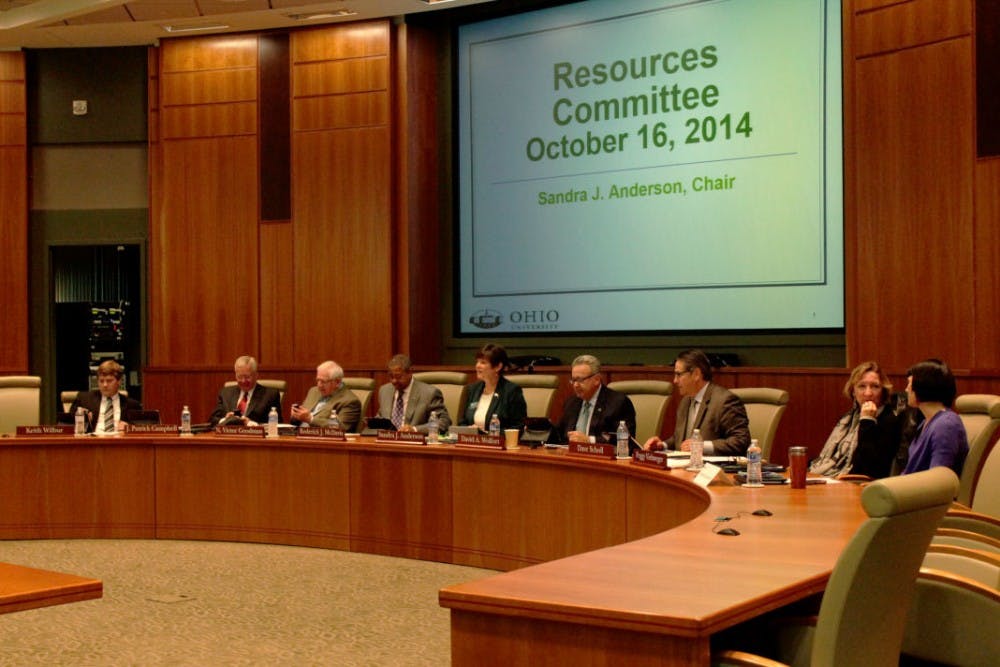The Board of Trustees bring up a possible descrease in state funding, recent OU records
Ohio University officials expressed anger and concern at Thursday’s Board of Trustees meeting over a potential loss of millions of dollars in state funding.
The trustees, OU President Roderick McDavis and top university officials discussed proposed changes to the way Ohio funds its public universities. Under the changes, OU is projected to lose the most state funding of any public university at 6.4 percent, or $9 million.
McDavis and others expressed frustration with the funding revisions, that come a year after Ohio’s public university presidents unanimously agreed on a new model to fund universities that ultimately financially benefitted OU.
OU received nearly 6.5 percent more in state funding compared to the year before — the second largest jump amongst Ohio’s public universities.
“A lot of folks are upset,” McDavis said. “We need to expand funding for higher education. We didn’t change the formula. We did what the state wanted us to do.”
McDavis blamed presidents of other Ohio universities for going back on last year’s plan.
The Board of Regents ultimately decide how the funding is distributed.
The changes would give universities less funding for “at-risk” students who completed at least 30 credit hours at another college or university then transferred to OU. They also argue students who have already completed 30 hours have shown they’re no longer “at-risk” and don’t deserve extra state funding.
“As a student, this makes me really angry,” said Keith Wilbur, the second-year student trustee on the board. Wilbur said the state is effectively saying a student who is “at-risk” initially — such as an African-American student from an inner-city high school — who attends a community college then transfers to OU is no longer “at-risk.”
“We will have to wait and see how this conversation turns out,” said Stephen Golding, vice president for Finance and Administration. “Nothing will happen until the presidents — and then the state — approves this.”
The Board of Regents agrees that nothing is decided yet.
“I believe other institutions share this concern as they also may see a number of students who transfer after earning credit hours at other schools,” said Jeff Robinson, director of communication for the Ohio Board of Regents.
Enrollment numbers and retention rates
The board discussed the university’s record enrollment and increased retention rates.
OU saw records in the number of multicultural; in-state; Appalachian county; first-generation students; and average high school GPA this year. The current freshman class comprises 4,379 students — an increase of 135 students from last year, according to university documents.
As of the meeting, 17,677 undergraduate students are on the Athens campus. Including the branch campuses and graduate students, there are 38,572 students in the OU system.
The university’s first-year retention rate went up 1.4 percent between the 2012-13 and 2013-14 academic years to 80.2 percent.
Making a profit
Plans to raise more than $12 million will be discussed behind closed doors Friday.
During Thursday’s meeting, Golding suggested the board discuss selling university properties — valued at $12.05 million — on E. State St. in executive session. The properties draw nearly half a million dollars in base rent a year.
The board was going to discuss the properties in the public meeting on Thursday, but, for unknown reasons, instead opted to speak privately.
— Compensation 2014, a plan to streamline how OU’s classified and administrative employees are paid, will be voted on at Friday’s meeting. The plan, if approved at Friday’s meeting, will change how classified and administrative employees at OU are paid. On Thursday, officials said the current pay structures are confusing, and there are employees with similar — if not identical jobs that are paid differently.
— Trustee Victor Goodman said OU’s office of NCAA compliance is “stretched too thin.” OU employs two full time NCAA compliance officers, making it one of the smallest staffs in the MAC, according to Lauren Ashman, director of intercollegiate athletic compliance at OU.
— The Ridges, a 700-acre site that includes 40 buildings, has three distinct sub-committees looking at its future: academic; land uses; and existing buildings. “Despite water damage and asbestos, the buildings are in somewhat better conditions than people think,” said Shawna Bolin, director of University planning and space management. “There is a strong desire to save the buildings.”
@WillDrabold
dd195710@ohiou.edu
— Seth Archer, Dina Berliner, Maria DeVito, Megan Henry, Jeremy Hill and Alisa Warren contributed to this report.






